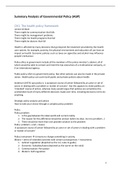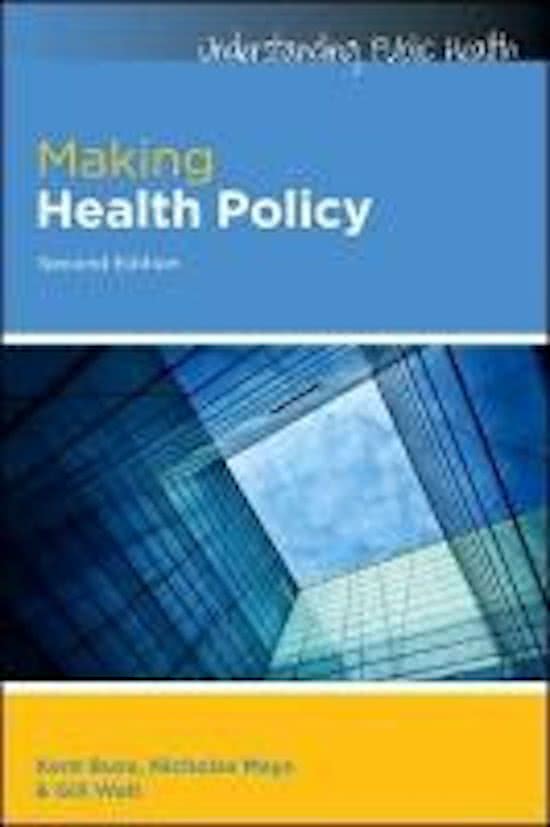Summary Analysis of Governmental Policy (AGP)
CH1: The health policy framework
Lecture & Book
There might be communication that fails
There might be management problems
There might me health programs that fail
There might be doctors that fail
Health is affected by many decisions that go beyond the treatment provided by the health
care system, for example, poverty, the physical environment and education all can have an
impact on health. Economic policies such as taxes on cigarettes and alcohol may influence
people’s behaviour.
Policy elites in government include all the members of the prime minister’s cabinet, all of
whom would be able to contact and meet the top executives of a multinational company, or
if an international agency.
Public policy refers to government policy. But other policies can also be made in the private
sector. Health policy can cover both public and private policies about health.
Anderson (1975) says policy is ‘a purposive course of action followed by an actor or set of
actors in dealing with a problem or matter of concern’. But this appears to make po0licy an
‘intended’ course of action, whereas many would argue that policies are sometimes the
unintended result of many different decisions made over time, including decisions not to do
anything.
Strategic policy analysis and advice
How to take your choice through a complex policy problem
Policy
Policy problem:
1. Is the gap between the ideal world and current reality
2. The reason for this difference should be unclear (when its clear, its not a problem…)
3. There should be more than one possible solution to the problem
Policy: problem + end + means
‘A purposive course of action followed by an actor or set of actors in dealing with a problem
or matter of concern’
Policy instrument → 4 means to change something in society.
Means = series of intended activities with certain consequences = instruments
1. Judicial: Legislation (depicted as the rot, rules to guide)
2. Economic: Subsidies/taxes (depicted as the carrot on the stick)
3. Communication: Persuasion
4. Modern: Self-regulation
1
,Policy is made at the very highest level of the organizations. Ministry where policy decisions
are being made
The health policy triangle is a highly simplified representation of a complex set of inter-
relationships.
All interact with eachother
Actors:
- individuals, organizations, groups, ‘states’
- inside government: members of parliament, ministers, bureaucrats, etc.
- outside government: groups that do not seek political power but may seek influence
o civil society organizations (church) (organizations that fall between the state
and the individual or household)
o pressure/interest groups (greenpeace)
o non-governmental organizations (cordaid)
o private sector companies
o international organizations (WHO)
o social movements
→ all those actors are divided into different levels of our society
Macro: political (government, steers whole state)
Meso: institutional (e.g. university, consumer association, greenpeace)
Micro: societal (us as persons)
Context:
- Situational factors: ‘focusing event’, violent events (war, coups), earthquake, new
disease epidemic (more or less transient or idiosyncratic conditions)
o Examples:
▪ A new prime minister/president coming to power and making AIDS
policy a priority
▪ The death of a famous person acknowledged publicly to be due to
AIDS
▪ New research findings on the prevalence of HIV in specific population
groups
2
, - Structural factors: political system, type of economy, technology, GNP, demography,
migration (relatively unchanging elements of society)
o Examples:
▪ The role of the media or NGOs in publicizing, or not, the AIDS epidemic
– relating to the extent to which the political system is open or closed
▪ Evidence of growing mortality from AIDS made public – perhaps
among a particular group such as health workers
- Cultural factors: religion, traditional, social values
o Examples:
▪ The actions of religious groups – both negative and positive – with
regard to people living with HIV or towards sexual behaviour
▪ Prevailing norms concerning sex work, homosexuality, concurrent
sexual partnerships, injecting drug use, and the position of women in
society
- International (exogenous) factors: leading to greater inter-dependence among states,
bilateral/multilateral aid (often happens in developing countries)
o Examples:
▪ The role of international donors – the extra funds brought in by global
initiatives such as the Global Fund to Fight AIDS, TB and Malaria
▪ Technical norms and standards promoted by international agencies,
for example, WHO’s guidelines for AIDS treatment initiation
▪ Drug donations or tiered pricing by pharmaceutical companies
Process:
Process refers to the way in which policies are initiated, developed or formulated,
negotiated, communicated, implemented and evaluated.
The most common approach to understanding policy process is to use what is called the
‘stages heuristic’ (policy cycle) (Sabatier and Jenkens-Smith 1993) → breaking down the
policy process into a series of steps, but acknowledging that this is a model, and does not
necessarily represent exactly what happens in the real world:
- Problem identification and issue recognition: What is the problem? Why do some
issues get on the policy agenda and others not? What are the solutions?
- Policy formulation: Who are involved? Communication? Decisions have to be worked
out
- Policy implementation (often the most neglected phase of policy making):
implementing in the world (most important)
- Policy evaluation: identifies what happens once a policy is put into effect → results in
feedback (change) or policy termination
After 5 years you van return to problem identification
3
, Health policy triangle is a model to simplify the complexity of policy making, but pays too
little attention to other factors that explain why and how policies change.
Shiffman and Smith: ‘issue characteristics’ may effect policy. By characteristics they mean
specific features of a particular issue (which could be a problem or a solution). For example
having credible indicators – clear measures that show the severity of the problem – may
affect how far the issue is perceived as urgent or not. They also stress the role of ideas (and
how evidence is framed) as being important to understanding change in the policy process.
Their framework builds on the policy triangle’s notions of actors and context, but instead of
context they use environment, but gives greater space for consideration of ideas and issue
characteristics.
Data analysis
Actor chart
Labeling
Causal analysis
What it costs to do the hard stuff
Numbers, ideas, experiences from patients, experiences from policymakers etc.
What is the issue, how is it structured, why is it not working
Key terms
• Actor = short-hand term used to denote any participant in the policy process that
affects policy, including individuals, organizations, groups and even the government
• Content = substance of a particular policy which details its constituent parts (e.g. its
specific objectives)
• Context = systemic factors – political, economic, social or cultural, both national and
international – which may have an effect on health policy
• Epistemic community = policy community marked by shared political values, and a
shared understanding of a problem and its causes
• Ideas = the values, evidence, anecdote and argument that shape policy, including the
way a policy problem or solution is presented
• Interest = what an actor or groups stands to gain or lose from a policy change
• Institutions = the ‘rules of the game’ determining how government and the wider
state operate. Institutions can be formal structures and procedures, but also informal
norms of behaviour that may not be written down
• Policy = broad statement of goals, objectives and means that create the framework
for activity. Often takes the form of explicit written documents, but may also be
implicit or unwritten
• Policy elite = specific group of policy makers who hold high positions in a policy
system, and often have privileged access to other top members of the same, and
other organizations
• Policy makers = those who make policies in organizations such as central or local
government, multinational companies or local businesses, clinics, or hospitals
• Policy process = the way which policies are initiated, formulated, developed,
negotiated, communicated, implemented and evaluated
4






